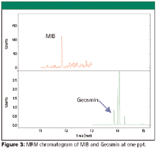Analysis of Geosmin and 2-Methylisoborneol (MIB) by Solid Phase Micro Extraction (SPME) and CI-MS-MS using the Varian 240 MS
The Application Notebook
Two of the most commonly occurring unpleasant odor-causing compounds in drinking water are geosmin and 2-methylisoborneol (MIB) (Figure 1). Geosmin is produced primarily by blue-green algae (cyanobacteria) and actinomycete bacteria, and MIB is produced by certain species of cyanobacteria, primarily Oscillatoria. Many environmental laboratories are required to detect these compounds as low as 1–3 ppt concentration and measure quantitatively at 5 ppt.
Two of the most commonly occurring unpleasant odor-causing compounds in drinking water are geosmin and 2-methylisoborneol (MIB) (Figure 1). Geosmin is produced primarily by blue-green algae (cyanobacteria) and actinomycete bacteria, and MIB is produced by certain species of cyanobacteria, primarily Oscillatoria. Many environmental laboratories are required to detect these compounds as low as 1–3 ppt concentration and measure quantitatively at 5 ppt.
Figure 1
Analytical methods utilizing SPME and GC–MS for the detection of geosmin and MIB have become standard procedure. Most reported methods can determine these two components quantitatively at 5 ng/L using EI-MS in SIM mode. Significant background interference limited the method to quantify at lower levels for these two components. In this note, a CI-MS-MS method was developed using a 2 cm 50/30 mm DVB/ Carboxen/PDMS SPME fiber and the Varian 240-MS ion trap mass spectrometer to measure geosmin and 2-methylisoborneol (MIB) quantitatively in water at concentrations near 1 ppt with good confidence.

MS-MS parameters
Materials and Methods
A 100-μg/mL stock solution of geosmin and MIB in methanol, IBMP and IPMP in methanol were purchased from Supelco (Bellefonte, Pennsylvania). A series of calibration standard were prepared in reagent water at concentrations ranging from 1 to 50 ppt (1, 2, 5, 10, 20, and 50 ppt) with 50 ppt of IBMP as internal standard and 50 ppt of IPMP as surrogate standard.

Figure 2
GC and SPME conditions:
Column: VF-5ms, 30 m × 0.25 mm, 0.25 mm film
SPME fiber: 2cm StableFlex coated with 50/30mm DVB/Carboxen/PDMS
Oven: 35°C for 2 min, to 125°C hold for 1 min, 10°C, to 300°C hold for 3 min, 25°C /min to 320, hold 2 min.
Flow rate: 1 mL/min
Injector: 1177
Sample: 12.5 mL water
MS Conditions:
Trap: 180°C
Manifold: 50°C
Transfer Line: 250°C
Target TIC: 5000
Max ion time: 2500 ms
Prescan Ion Time: 250 ms
CI reagent: methanol
Results and Discussion
Geosmin and 2-methylisoborneol were determined quantitatively using the product ions described in the method by CI-MS-MS with methanol as liquid reagent. The matrix effects were eliminated using the MS-MS mode. This greatly improved the sensitivity of the method. Under current conditions, both geosmin and MIB can be determined quantitatively as low as one ppt. (Figure 3).

Figure 3
MS-MS delivers excellent spectral clarity and unique clean product ion spectra even as low as 0.5 ppt. The spectrum at 0.5 ppt matches very well to that at 50 ppt (Figure 4).

Figure 4
Both MIB and geosmin showed good calibration with low % RSD over the concentration range from 1 to 50 ppt. The accuracy and precision of geosmin and 2-methylisoborneol were determined from seven replicates at one ppt concentration (Table I). The MDL of geosmin and 2-methylisoborneol was calculated to be 0.20 and 0.46 ppt, respectively.
Table I: Accuracy and precision of geosmin and 2-methylisoborneol in reagent water (n=7)
Conclusion
This note provides a CI-MS-MS method for the analysis of odor-causing components, geosmin, and 2-methylisoborneol, quantitatively as low as 1 ppt concentration level. The method is able to detect these two components at 0.5 ppt with high quality spectral matches. The method also demonstrated excellent precision and accuracy, even at trace levels with detection limits of 0.20 ppt and 0.46 ppt for geosmin and MIB, respectively. This MS-MS method significantly eliminates matrix effects commonly observed in SPME extractions, providing lower detection levels and greater confidence for identifying these components at trace levels.

Varian, Inc.
25200 Commercentre Drive, Lake Forest, CA 92630-8810
Tel: 949-770-9381, Fax: 949-770-0863


.png&w=3840&q=75)

.png&w=3840&q=75)



.png&w=3840&q=75)



.png&w=3840&q=75)













